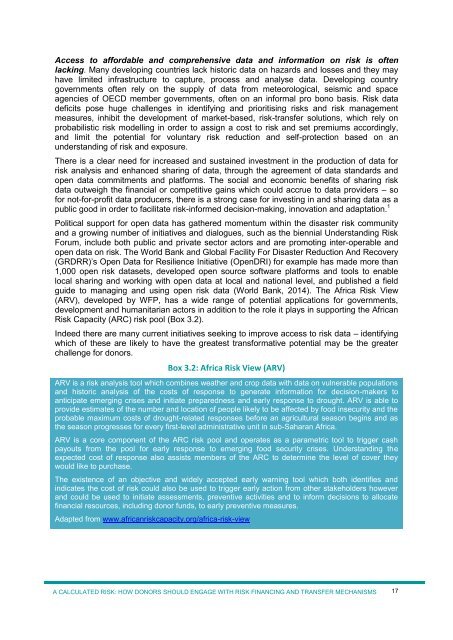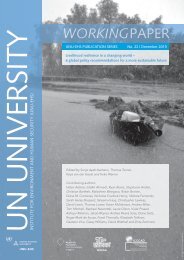k5q82a3
k5q82a3
k5q82a3
You also want an ePaper? Increase the reach of your titles
YUMPU automatically turns print PDFs into web optimized ePapers that Google loves.
Access to affordable and comprehensive data and information on risk is often<br />
lacking. Many developing countries lack historic data on hazards and losses and they may<br />
have limited infrastructure to capture, process and analyse data. Developing country<br />
governments often rely on the supply of data from meteorological, seismic and space<br />
agencies of OECD member governments, often on an informal pro bono basis. Risk data<br />
deficits pose huge challenges in identifying and prioritising risks and risk management<br />
measures, inhibit the development of market-based, risk-transfer solutions, which rely on<br />
probabilistic risk modelling in order to assign a cost to risk and set premiums accordingly,<br />
and limit the potential for voluntary risk reduction and self-protection based on an<br />
understanding of risk and exposure.<br />
There is a clear need for increased and sustained investment in the production of data for<br />
risk analysis and enhanced sharing of data, through the agreement of data standards and<br />
open data commitments and platforms. The social and economic benefits of sharing risk<br />
data outweigh the financial or competitive gains which could accrue to data providers – so<br />
for not-for-profit data producers, there is a strong case for investing in and sharing data as a<br />
public good in order to facilitate risk-informed decision-making, innovation and adaptation. 1<br />
Political support for open data has gathered momentum within the disaster risk community<br />
and a growing number of initiatives and dialogues, such as the biennial Understanding Risk<br />
Forum, include both public and private sector actors and are promoting inter-operable and<br />
open data on risk. The World Bank and Global Facility For Disaster Reduction And Recovery<br />
(GRDRR)’s Open Data for Resilience Initiative (OpenDRI) for example has made more than<br />
1,000 open risk datasets, developed open source software platforms and tools to enable<br />
local sharing and working with open data at local and national level, and published a field<br />
guide to managing and using open risk data (World Bank, 2014). The Africa Risk View<br />
(ARV), developed by WFP, has a wide range of potential applications for governments,<br />
development and humanitarian actors in addition to the role it plays in supporting the African<br />
Risk Capacity (ARC) risk pool (Box 3.2).<br />
Indeed there are many current initiatives seeking to improve access to risk data – identifying<br />
which of these are likely to have the greatest transformative potential may be the greater<br />
challenge for donors.<br />
Box 3.2: Africa Risk View (ARV)<br />
ARV is a risk analysis tool which combines weather and crop data with data on vulnerable populations<br />
and historic analysis of the costs of response to generate information for decision-makers to<br />
anticipate emerging crises and initiate preparedness and early response to drought. ARV is able to<br />
provide estimates of the number and location of people likely to be affected by food insecurity and the<br />
probable maximum costs of drought-related responses before an agricultural season begins and as<br />
the season progresses for every first-level administrative unit in sub-Saharan Africa.<br />
ARV is a core component of the ARC risk pool and operates as a parametric tool to trigger cash<br />
payouts from the pool for early response to emerging food security crises. Understanding the<br />
expected cost of response also assists members of the ARC to determine the level of cover they<br />
would like to purchase.<br />
The existence of an objective and widely accepted early warning tool which both identifies and<br />
indicates the cost of risk could also be used to trigger early action from other stakeholders however<br />
and could be used to initiate assessments, preventive activities and to inform decisions to allocate<br />
financial resources, including donor funds, to early preventive measures.<br />
Adapted from www.africanriskcapacity.org/africa-risk-view<br />
A CALCULATED RISK: HOW DONORS SHOULD ENGAGE WITH RISK FINANCING AND TRANSFER MECHANISMS<br />
17



